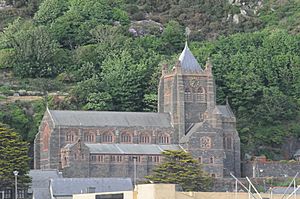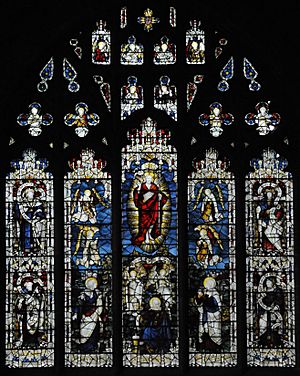St John's Church, Barmouth facts for kids
Quick facts for kids Church of Saint John the Evangelist |
|
|---|---|

Photo of St John's Church taken from Barmouth Beach
|
|
| 52°43′24″N 4°03′17″W / 52.7233°N 4.0548°W | |
| Denomination | Church in Wales |
| History | |
| Status | Parish Church |
| Founded | 1889 |
| Dedication | St John the Evangelist |
| Consecrated | April 1895 |
| Architecture | |
| Functional status | Active |
| Heritage designation | II* |
| Designated | 31 January 1995 |
| Architect(s) | John Douglas & Daniel Fordham |
| Style | Restrained Perpendicular |
| Years built | 1889-1895 |
| Groundbreaking | August 1889 |
| Completed | April 1895 |
| Construction cost | £33,500 |
| Specifications | |
| Capacity | 1,000 seated (reduced to 620) |
| Materials | Local stone & Cheshire Sandstone |
| Bells | 8 (Change Ringing, Ellacombe, Clock Chime) |
| Tenor bell weight | 22-1-1 |
| Administration | |
| Parish | Bro Ardudwy |
| Deanery | Meirionydd Synod |
| Diocese | Bangor |
St John's Church in Barmouth, Gwynedd, Wales, is a beautiful old building. It was built between 1889 and 1895. Two architects from Chester, Douglas and Fordham, designed it.
A very important person, Princess Beatrice of the United Kingdom, helped start the building work. She laid the first stone! Most of the money for the church came from Mrs. Sarah Dyson Perrins. She gave the money to remember her husband, James Dyson Perrins. His family was famous for making Lea & Perrins sauce.
St John's Church is part of the Church in Wales. It is a special building because it is a Grade II* listed building. This means it is very important and protected. Cadw, a Welsh heritage group, gave it this status on January 31, 1995.
Contents
History of St John's Church
In 1830, a new church called Saint David's opened in Barmouth. It was built because more people were moving to the town. The older church, St Mary and Bodfan in Llanaber, was too far away.
Back then, trains had not reached this part of Wales. So, Barmouth mainly relied on the sea for jobs. But in the 1860s, the railway arrived! This brought many more tourists to Barmouth.
Why a New Church Was Needed
In 1887, Edward Hughes became the church leader for Llanaber and Barmouth. He quickly saw that Barmouth needed a much bigger church. They tried to make St David's church bigger, but it didn't work.
So, in 1887, Hughes suggested building a brand new, larger church. The church leaders agreed. Then, they started looking for a good place to build it.
Finding a Location
Barmouth is located between mountains and the sea. This meant there weren't many places to build a big church. But someone donated a rocky spot high above the town. Everyone agreed it was the perfect choice!
The design by Douglas and Fordham was chosen. People started raising money for the building. Then, something amazing happened! Mrs. Sarah Perrins gave a huge donation of £15,000. This money paid for important parts of the church. These included the main altar area, the central tower, and other special rooms. She gave this money to remember her husband. Mrs. Perrins and her family had a holiday home in Barmouth. They knew how much the town needed a bigger church.
Building Challenges
St John's took seven years to build. The first stone was laid in 1889 by Princess Beatrice. The church was officially opened in November 1895 by Bishop Cambell of Bangor.
There were some problems during construction. On September 11, 1891, the church was almost finished. The roofs were not yet covered, and the tower was nearly done. But that evening, the tower fell down! It crashed into the church, destroying most of the roofs and walls on one side. The architects said the collapse happened because of blasting work behind the church. This work was meant to let more light into the building.
Interesting Features of St John's
The Font
The font is a large bowl used for baptisms. It is at the back of the church. This font is a copy of a famous one in Copenhagen Cathedral in Denmark. It is made from pure marble.
The Lectern
The lectern is a stand where the Bible is read. It was made in Frome. It is crafted from wrought iron and copper. The design shows a picture of a farmer planting seeds.
The Bell Tower
The tower has 8 bells made by Mear and Stainbank in London. There is also a clock mechanism from 1897. This clock plays the famous Westminster Chimes using some of the bells.
Stained Glass Windows
St John's has nine beautiful stained glass windows. They were made by a famous artist named C. E. Kempe.
The main East Window shows Jesus with his twelve followers and St John. The West Window shows Jesus after he rose from the dead, with angels. The windows on the sides of the main altar area show scenes from the resurrection story. These include Easter Morning and Jesus with Thomas. The three windows in the Lady Chapel show the Annunciation and the Nativity.
The Organ
The church was designed with a special place just for the organ. This makes it easy to reach all parts of the organ for tuning and care. Mrs. Perrins' daughter, Mrs. Sarah Gertrude Potter, gave money for the organ. Her family was from Worcester, so Nicholson & Co of Worcester was chosen to build it. The organ was brought to Barmouth by train.
The organ has three keyboards and a pedal section. It has 34 different sounds, called stops.
This organ was installed in 1895 and has not had a major repair since. It was cleaned in the 1970s and gets tuned every year. The only change was adding an electric blower system in the 1950s. The organ is so original that three volunteers can still pump it by hand if needed!
Before 1895, organs were very rare in churches nearby. Only one church in Dolgellau had a small barrel organ. When it was built, St John's organ was almost as big as the largest organ in North Wales, which was in Bangor Cathedral. It is still one of the biggest organs in North Wales today.
Over the next twenty years, Nicholson & Co built four more pipe organs in churches and chapels in Barmouth.
See also








